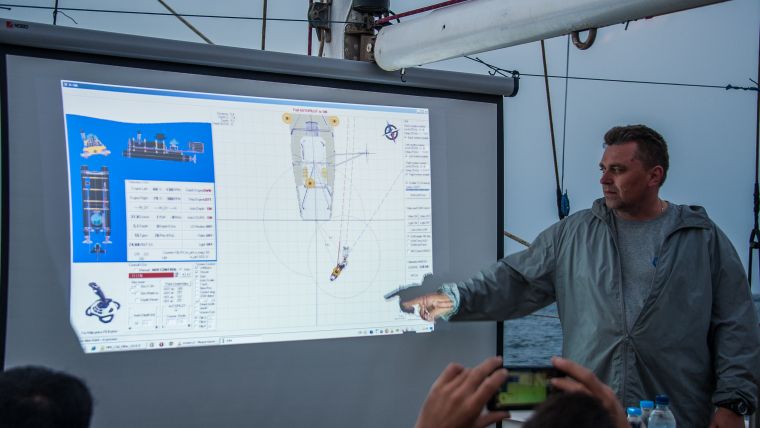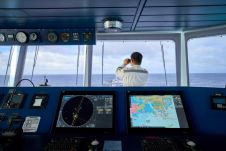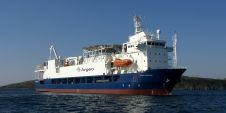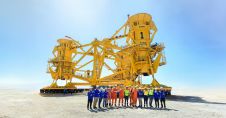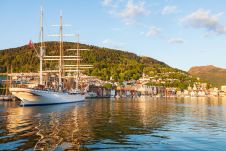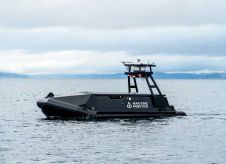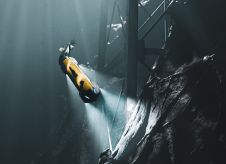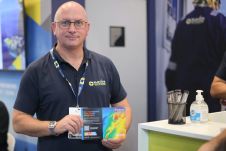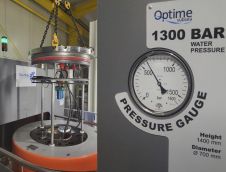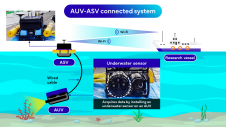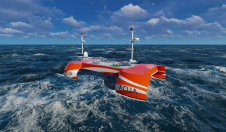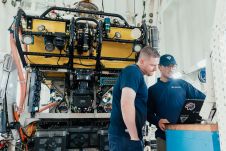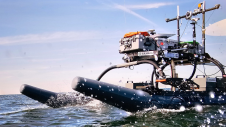Underwater Wireless Video Communication
New Horizon of Underwater Explorations
This article presents the development, production and testing of wireless underwater acoustic video communications, which is unique in the world today. It also discusses the implementation of this technique on Autonomous Underwater Vehicles (AUV’s) to perform inspections of underwater oil and gas pipelines. The achieved characteristics, limitations and upcoming prospects are presented.
Currently, there are about 1000 Remotely Operated Vehicles (ROVs) and up to 700 AUVs in the world, according to Douglas-Westwood. In the coming 4 to 5 years it is expected that this fleet can be increased by 50-60% and may be even more than doubled.
The vast majority of AUVs currently belongs to the defence industry, where they are called Unmanned Underwater Vehicles (UUV). There is no difference in meaning between UUV and AUV, but the abbreviation UUV is used in the defence industry and in military circles, and therefore correspond to military applications; AUV is used in civil applications. In the military applications, approximately 35% are ‘heavy’ vehicles, 25% are ’middle’vehicles and 40% are ’light’ vehicles.
The majority of heavy ROV vehicles are used in drilling and construction support of the subsea infrastructure in the oil & gas industry. Light ROV vehicles are often used in Inspection Repair and Maintenance (IRM). Of these approximately 70-80 percent of all ROVs are ‘heavy’ to ‘medium’ and 20-30% are ’light’ vehicles.
There have been attempts to shift UUV applications from the defence to civil market, assuming that AUVs will take over some IRM tasks from ROVs. Much attention has been paid to deep water ROV & AUV operations in depths up to 3,000 metres of water. Although from a market point of view, such ‘frontier types’ of vehicles will not be decisive because about 80% of the total pipelines length are located in depths shallower than 500 metres.
The Oil & Gas industry has been under pressure over the past 2 years, which has resulted in a challenge to reduce prices and therefore also a critical review of approaches to development in the industry. For example, with regard to IRM of underwater pipelines. Currently the total length of pipelines in the world is approximately 150 thousand km, and will increase by 20% towards 2019. As a majority of these pipelines is older than 20-25 years, the approaching end of their life cycle will mean that the requirements with respect to conducting regular inspections will be tightened and the inspection frequency increased.
Ecological requirements and government regulations will press the operators to increase IRM operations with the increasing of age of pipelines, despite the decline in oil prices. Furthermore, the need to optimize the budgets in this situation requires the introduction of new advanced technologies, including the transition from ROV-based inspections to AUV-based ones.
Thus, the objective reasons and formal requirements force operators to increase the operating costs while the optimisation of budgets is more urgent on the agenda!
What does this means in terms of money’? – The cost of renting a vessel with an ROV is roughly estimated to be around USD100,000 per day. The ‘availability factor’ taking into account the weather conditions influence is about 0.3 in the equatorial regions, and less in the North Sea. In theory, vessel & ROV can inspect some 10-20km per day, but the actual average productivity per day is usually about 2-5km per day due to missed days/weeks of hard weather! This initial data will enable us to calculate that for 5km the financing of the inspection of 25% of extent would be around USD2-3 billion! This is a substantial amount. Although, if you consider that BP paid USD62 billion for the Deepwater Horizon spill in 2010, and the real damage to nature cannot really be estimated, the USD 2-3 billion seem to be fully justified. Any possible optimisations will therefore be welcomed by operators.
There are also some ROV limitations: hooks’ of tethers, ’start’ and ’extracting’ breaks, weather limitations etc.
Automation can be used to optimise these costs. In this case we can attain greater effectiveness if we expand the limits for weather conditions and have more ‘availability factor’. The first and the second lead to AUVs instead of ROVs.
“The lack of breakthroughs in wireless underwater communication and battery capacity is prolonging the wait for a fully autonomous underwater vehicle (AUV), one that will not need a USD100,000/day vessel and crew, a heavy tether for power and control or hours to complete a task that might take minutes onshore.” This quote clarifies the essence of the problem: to go to the automatic inspection on the basis of AUVs it was necessary to first solve the problem of transmitting video wirelessly. The problem of power is not very critical for light AUVs, it is quite acceptable to have batteries that provide mission durations of up to 24 hours or even more. When an AUV can cruise up to a speed of 5 knots it has the possibility of carrying out inspections at a distance of 100 km!
The History of Wireless Underwater Video Development
Dozens of scientific and industrial groups from almost all the leading countries of the world have been involved in developments over the past 20 years. BaltRobotics have designed a solution and successfully tested it.
However, the mere existence of the underwater wireless video transmission channel is not yet the NDT application for the inspections of oil & gas subsea pipelines.
Firstly, a specialised vessel is required for permanent marine testing, which is a key element of the cost to develop a system. The lack of testing in real marine environments can be seen as the main factor for failure. BaltRobotics redesigned the former German Fish Hunter vessel built in 1935 and combined special laboratories and scientific facilities.
An AUV X-3A was designed with all needed subsystems: DVL & INS, SBL, etc. The AUV X-3A differs from many other solutions in that it has a ’Dynamic Positioning’ mode that it critical in offshore but usually absent in UUVs; and the automatic routing system was also implemented. This means that AUV X-3A can be remotely controlled wirelessly simply using a joystick. A demonstration of the vessel & AUV complex was held on 21 May 2015 in Malta (St. Julian’s Bay, Sliema).
The vessel, Maeksa, is a motor sailing boat 21m in length with 66 tons of displacement. Initially it that was a former ’fish hunter’ made in Germany before WWII. The vessel was equipped with SBL (Short Base Line) reference navigation system for AUV, wireless underwater acoustic video communication channel and command channel for AUV. During the demonstration the audience on board was presented:
- wireless undersea acoustic video communication – AUV transmitted the video online; for which it used the ‘softly constructed’ target (to be constantly moving) – the ’white tube’ with the signatures of participants to prove the video was real and valid,
- the automatic routing of AUV was demonstrated by one of the participants who had no previous experience of controlling undersea vehicles,
- Dynamic Positioning of AUV was demonstrated (DP) with the bottom current in the bay around 1m per second (see the photos).
Configuration and Channel Characteristics
The System has adapted its characteristics to the remote control mode – ‘wireless ROV’ mode. This is very important at the beginning of the inspection mission: to search the pipeline, to search sacrificial anode, etc. All this can be wirelessly controlled remotely at a distance up to 200m. Is this a lot or a little? More than 50% of the length of the undersea oil & gas pipelines in 2015 were at depths of 0-100m, and about 20% were at a depth of 100m to 500m, i.e. on the continental shelf (depths up to 500m). Thus there are more than 50% of all subsea pipelines that can be inspected by the systems with underwater wireless video.
|
Acoustic High Data Rate Modem: working distance – till 0.2km; data rate – 115.2kbod; full duplex mode; interface – Ethernet. |
|
Antenna with Positioning & Control System: frequency - 500kHz/1000kHz; beam width - 4˚. |
|
Video Camera: HD |
|
Video Blaster (Black Magic) |
|
PC & ‘NVideo-560’ (processors – 512 cores, 0.9 GHz) |
|
Underwater Unit Software for Video Compression of ’UltraVNP-Compression Algorithm’: 0.02 bit per pixel; 30 frames per sec; buffering – 0.1 sec. |
Table 1. System parameters and configuration.
Prospects
Research conducted by BaltRobotics revealed that the principal limit for wireless underwater acoustic video, namely 500m, will be difficult to overcome in the nearest future. The current plans of the company are to enlarge the working distance to 350m.
More Information
Bruce Nichols. Surveying the field in the search for fully autonomy. by // Offshore Engineer, January 2013.
www.infield.com/market-forecast-reports/offshore-pipelines-control-lines-market-report

Value staying current with hydrography?
Stay on the map with our expertly curated newsletters.
We provide educational insights, industry updates, and inspiring stories from the world of hydrography to help you learn, grow, and navigate your field with confidence. Don't miss out - subscribe today and ensure you're always informed, educated, and inspired by the latest in hydrographic technology and research.
Choose your newsletter(s)
